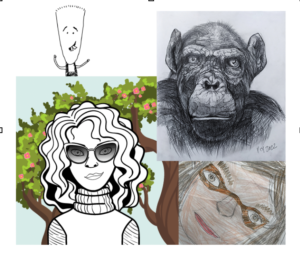I promise this is not going to be a philosophical discussion, but a rather practical view on the topic. In a discussion of a new design degree at the OU (we call it ‘BDes’), a group of academics mused about how you are present (or what of you is present) when you are studying at the distance, and why it matters to us.
We started off with an insight into student experiences. We know about some students who miss seeing ‘faces’, for example, in tutorials, the video camera is often turned off, we learnt, and students aren’t talking either. The materials we provide and the interactions on the forum are text-based. It is difficult to really ‘read’ another person from a text only, and easy to offend with unfortunately-chosen words. Some feel isolated or detached from others because they don’t see the person, or their face on a screen. The face is certainly a crude proxy for the whole person. Many of us have probably experienced this during the pandemic when we all had to rely on Teams, Zoom or Facetime interactions. Nevertheless, the face is a familiar focus to engage with others. We look people in the eyes to make contact, we observe peoples’ lips to get a better grasp of what they say. Moving on to the whole person, we interpret body language to understand what someone is saying (or hiding). How can online study offer such subtle means to engage with others, tutors, or peers? How can you signal ‘I am here’, ready to talk or play or work, I am present?
And then we know about the flip side from students who say: ‘I don’t want to engage or interact with others at all’. They are frustrated with the module team, continuously asking them to participate and interact when all they want to do is get through materials in their own time, get a degree and get over it. And for some it may be a relief not to be present not having a body in a lecture hall, a studio, or in a workshop at the distance.
So, why is presence important then? We know from academic literature that telepresence is a ‘thing’. It might be found in ‘faces on video’, or in avatars (one of our colleagues mentioned that his avatar always has a tail, interesting, isn’t it?), or in other objects you produce online, images you upload, or text you post. Being present (in whatever form) is important to develop a feeling of belonging, it is important to persist with studying, and to succeed in your qualification and to become a professional designer. Only when you are present others can see you.

Avatars of some of the BDes group members
Think of this as something like a team sport. When you start missing training sessions or even a tournament, you don’t hang out after training or you don’t observe your teammate’s new skill or trick, or you can’t celebrate a win, or moan a loss. You start to feel you don’t belong and care less and you may drop out entirety. Your team captain or a team mate maybe talks to you about missing out, not being present. So, you reconsider and hopefully persist, and if you do, you have a much better chance at succeeding. Doing a design degree is not dissimilar. You are in for the long-haul, your body might not be there but something of ‘you’ needs to be present to make it to the end. Hence, we think about presence in distance design education, we discuss about how students and tutors and even external partners may connect remotely and feel present, feel they belong, feel they succeed. You may exchange the metaphor of team sport with that of a family, or a friend.
Unfortunately, unlike a team, a family or a friend, it is not easy to spot when you are not present in distance design education. Being aware that not all students want to sign up to a team, gain a new family or friend when they sign up to a module or qualification, we would still be very interested to know: ‘what keeps you going’?
Would you like to discuss your experiences of being ‘present’ when you study on a qualification, including before registration and in between modules, as well as after graduation? Are you curious how such a ‘long space’, a ‘space to belong’ could look and feel like?
Get in touch to share your views, or sign up to a forthcoming workshop on Eventbrite:
https://www.eventbrite.co.uk/e/designing-the-long-space-a-space-to-belong-tickets-268850106907

Leave a Reply